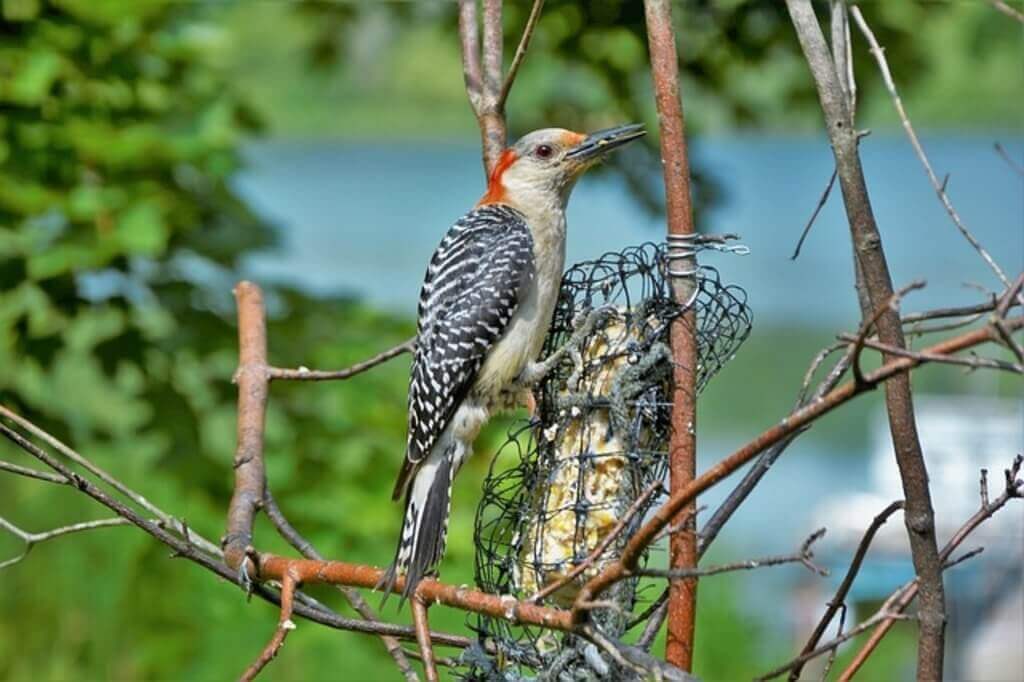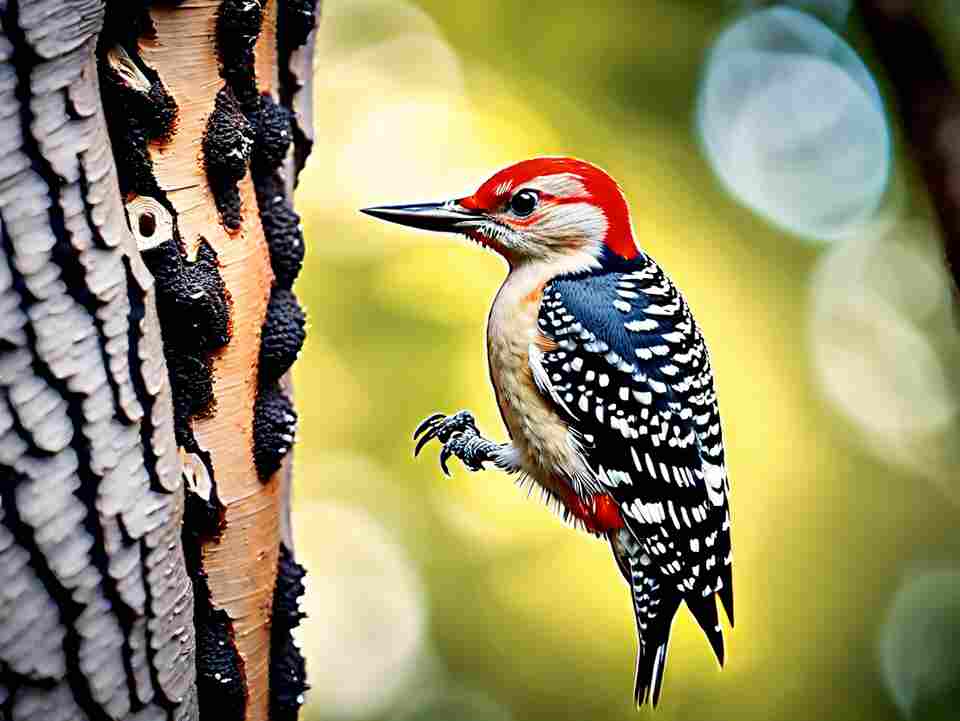Hey there! Got a hankering to turn your yard into the hottest hangout spot for red-bellied woodpeckers? I sure do! These feisty little birds bring so much energy and color to any backyard. So, let’s roll up our sleeves and find out how we can make our place their favorite joint to chill. Get ready for some fun times and bird-watching adventures right in our own backyard!
Table of Contents
Key Takeaways:
- Offer diverse food options like suet, nuts, and insects.
- Provide suitable nesting spots such as old trees or birdhouses.
- Maintain a pesticide-free environment for their health.
- Install a birdbath for drinking and bathing needs.
- Keep shrubs and trees for perching and foraging.
Effective Strategies to Attract Red-Bellied Woodpeckers
Characteristics and Habitat of Red-Bellied Woodpeckers
Red-bellied woodpeckers are a common sight in many parts of North America, known for their distinctive red caps and striking black-and-white barred backs. These medium-sized birds are adept at climbing tree trunks and foraging for insects, nuts, and fruits. Understanding their unique characteristics and habitat preferences is the first step in attracting these vibrant creatures to your backyard.
Providing Suitable Nesting Sites
Red-bellied woodpeckers are cavity nesters, meaning they prefer to build their homes in the hollows of trees or artificial nest boxes. To attract them, consider installing woodpecker-friendly nest boxes in your yard, preferably near mature trees or wooded areas. These boxes should have a diameter of 4-6 inches and a depth of 12-15 inches, with a 1.5-inch diameter entrance hole. Positioning the nest box in a shaded area and away from direct sunlight can also make it more appealing to these birds.
Offer a Diverse Feeding Menu
Red-bellied woodpeckers are omnivorous, meaning they feed on a variety of foods. Offering a diverse menu of suet, nuts, seeds, and fruits can help attract these birds to your backyard. Consider hanging suet feeders, filling tube feeders with a blend of sunflower seeds and nuts, and placing platform feeders with a variety of fruit and seed options. Keeping the feeders clean and well-stocked will encourage the woodpeckers to visit regularly.
Create a Bird-Friendly Landscape
Landscaping your yard to provide a suitable habitat for red-bellied woodpeckers can greatly increase your chances of attracting them. Plant a mix of native trees and shrubs that offer both nesting sites and a reliable food source. Oak, hickory, and other nut-bearing trees are particularly attractive to these birds. Additionally, leaving dead or decaying trees or branches can provide valuable foraging opportunities, as red-bellied woodpeckers often search for insects in the bark and crevices of these structures.
Limit Disturbances and Provide Water
Red-bellied woodpeckers are sensitive to human activity and prefer relatively quiet, undisturbed areas. Avoid placing feeders or nest boxes near high-traffic zones or areas with frequent human or pet activity. Additionally, providing a reliable source of fresh water, such as a birdbath or small shallow pond, can further entice these birds to your backyard.
Patience and Persistence
Attracting red-bellied woodpeckers to your yard may take time and patience. These birds can be somewhat territorial and may not immediately take to your efforts. Persisting with your bird-friendly landscaping and consistent feeding regimen can gradually increase the chances of these vibrant birds becoming regular visitors to your outdoor space.
By understanding the unique needs and preferences of red-bellied woodpeckers and incorporating these strategies into your backyard, you can create an inviting environment that will delight both you and these captivating feathered friends.
Ideal Habitat and Feeding Preferences for Red-Bellied Woodpeckers
Exploring the Ideal Habitats and Feeding Preferences of Red-Bellied Woodpeckers
Red-bellied woodpeckers are a common sight in many North American regions, known for their distinctive red napes and bellies. These vibrant birds are not only visually captivating but also play a vital role in the ecosystem. Understanding their ideal habitat requirements and feeding preferences can help us better appreciate and conserve these fascinating creatures.
Ideal Habitat Considerations for Red-Bellied Woodpeckers
Red-bellied woodpeckers thrive in diverse forest environments, including deciduous, mixed, and coniferous forests. They prefer areas with a mix of mature trees, as they rely on the presence of dead or decaying wood for nesting and foraging. These woodpeckers often seek out trees with loose bark or existing cavities, which provide them with essential nesting and roosting sites.
In addition to the type of forest, the presence of a varied canopy structure is crucial for red-bellied woodpeckers. They require a mix of tall, mature trees and younger, smaller trees or shrubs to meet their diverse needs. This diverse canopy structure not only provides ample nesting opportunities but also supports a rich variety of insect populations, which are a primary food source for these birds.
Another important habitat requirement for red-bellied woodpeckers is the availability of water sources. These birds often frequent areas near streams, rivers, or ponds, as they need a reliable source of drinking water and may occasionally forage in these aquatic environments.
Feeding Preferences and Foraging Behavior
Red-bellied woodpeckers are opportunistic feeders, with a diverse diet that includes insects, nuts, seeds, and fruits. Their foraging behavior is adaptable, allowing them to take advantage of a wide range of food sources.
One of the primary food sources for red-bellied woodpeckers is insects, particularly beetles, ants, and larvae. These birds are adept at locating and extracting insects from the bark and crevices of trees, using their sharp beaks to probe and extract their prey. They also supplement their diet with nuts, such as acorns and hickory nuts, which they store for winter consumption.
In addition to their insect and nut-based diet, red-bellied woodpeckers will also feed on various fruits and berries, particularly during the summer and fall months. They may visit backyard birdfeeders, where they can take advantage of offered seeds, suet, or fruit.
Nesting and Breeding Habits
Red-bellied woodpeckers are cavity nesters, relying on natural cavities or excavating their own nesting sites in dead or decaying trees. They often prefer to nest in areas with a mix of mature and younger trees, as this provides them with ample nesting opportunities and a diverse food source for their young.
The breeding season for red-bellied woodpeckers typically begins in the early spring, with the birds forming monogamous pairs and engaging in courtship displays. The female will lay a clutch of 3-6 eggs, which both parents will incubate for approximately 12-14 days. The hatchlings then remain in the nest for several weeks, being fed and cared for by both parents until they are ready to fledge.
Red-bellied woodpeckers are a fascinating and ecologically important species, playing a vital role in forest ecosystems. By understanding their ideal habitat requirements and feeding preferences, we can better appreciate and protect these remarkable birds. Preserving diverse forest environments, maintaining a healthy balance of mature and younger trees, and providing access to water sources are all crucial steps in ensuring the long-term success of red-bellied woodpecker populations.
Conclusion
Attracting red-bellied woodpeckers to your backyard or local area requires a thoughtful approach that considers their unique habitat preferences and feeding needs. By creating an environment that caters to these fascinating birds, you can not only enjoy their vibrant presence but also contribute to the conservation of this species.
One of the most crucial factors in attracting red-bellied woodpeckers is providing the right type of habitat. These birds thrive in mature, deciduous forests with a mix of dead and dying trees, as well as areas with a diverse array of tree species. Ensuring your backyard or local area has a good number of these essential habitat elements can go a long way in drawing these woodpeckers in.
When it comes to feeding, red-bellied woodpeckers are quite versatile, but they do have some distinct preferences. They are known to feed on a variety of insects, including ants, beetles, and larvae, as well as fruits and nuts. Providing a variety of high-energy food sources, such as suet feeders, nut-based seed mixes, and fresh fruit, can be an effective way to lure these birds to your area.
One important consideration when setting up feeding stations is placement. Red-bellied woodpeckers prefer to feed in areas with good visibility, where they can keep an eye out for potential predators. Positioning your feeders near trees or other cover can provide the perfect balance of safety and access to the food.
In addition to providing the right food and habitat, it’s also crucial to create a safe and welcoming environment for the red-bellied woodpeckers. This means keeping the area free of clutter, maintaining a clean and well-maintained landscape, and minimizing disturbances that could scare the birds away.
By following these effective strategies, you can increase your chances of attracting red-bellied woodpeckers to your backyard or local area. Not only will you be able to enjoy their vibrant plumage and lively antics, but you’ll also be contributing to the conservation of this essential species.
However, it’s important to remember that attracting wildlife is not just about providing the right resources; it’s also about respecting and understanding the needs of the animals themselves. Red-bellied woodpeckers, like all wildlife, deserve to be treated with care and consideration. By approaching this endeavor with a genuine respect for these birds and their habitats, you can create a mutually beneficial relationship that enriches both your life and the lives of the red-bellied woodpeckers you attract.
Attracting red-bellied woodpeckers to your backyard or local area requires a comprehensive approach that addresses their specific habitat and feeding preferences. By creating an environment that caters to their needs, you can not only enjoy the presence of these fascinating birds but also contribute to their conservation. Remember, the key to success lies in striking a balance between providing the right resources and respecting the well-being of the red-bellied woodpeckers themselves.





